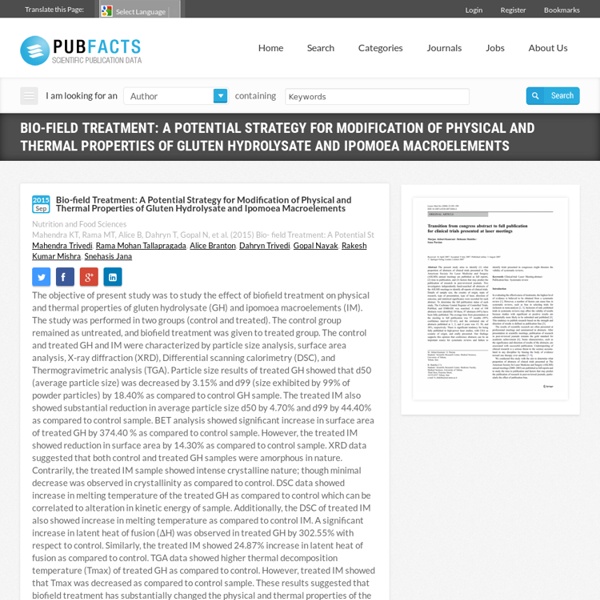



Influence of Human Biofield Energy on Pharmaceutical Drugs Disulfiram is being used clinically as an aid in chronic alcoholism, while nicotinic acid is one of a B-complex vitamin that has cholesterol lowering activity. The aim of present study was to investigate the impact of biofield treatment on spectral properties of disulfiram and nicotinic acid. The study was performed in two groups i.e., control and treatment of each drug. The treatment groups were received Mr. Trivedi’s biofield treatment.
Characterization of Biofield Energy Treated Neopentyl Glycol Neopentyl glycol (NPG) has been extensively used as solid-solid phase change materials (PCMs) for thermal energy storage applications. The objective of the present study was to evaluate the impact of biofield treatment on physical, spectral and thermal properties of NPG. The study was performed in two groups (control and treated). Significant Impact of Biofield Treatment on Shigella sonnei Shigella sonnei (S. sonnei) is a non-motile, rod shape, clinically significant, Gram-negative bacterium. It is commonly associated with dysentery (shigellosis). Recently, resistance to third and fourth generation cephalosporins and fluoroquinolones has been reported in S. sonnei.
Biofield | An Alternative Approach to Cure Streptococcus group B Infected Patients Streptococcus agalactiae group B (S. agalactiae gr. B) is widespread in nature mainly causes bacterial septicemia and neonatal meningitis. The current study was attempted to investigate the effect of biofield treatment on S. agalactiae gr. B with respect of antimicrobial sensitivity, biochemical reactions and bio typing.
Antimicrobial Susceptibility Assay of Biofield treated Shigella Flexneri Shigellosis is a major public health burden in India and its neighboring countries due to infection of Shigella species. The current study was attempted to investigate the effect of biofield treatment on Shigella flexneri (S. flexneri) with respect of antimicrobial susceptibility assay, biochemical characteristics and biotyping. The American Type Culture Collection (ATCC 9199) strain of S. flexneri was used in this experiment. The study was conducted in revived and lyophilized state of S. flexneri. Both revived (Group; Gr. II) and lyophilized (Gr.
Biofield Treatment | Integrative Oncology | Human Brain Cells Study background: Glioblastoma (GBM) is the most common subtype of primary brain tumor in adults. The aim was to evaluate the impact of biofield treatment potential on human GBM and non-GBM brain cells using two time-lapse video microscopy technique. Methods: The human brain tumor, GBM cultured cells were divided into two groups viz.
Evaluation of Biofield Energy Treatment on Enterobacter cloacae This research work investigated the influence of biofield treatment on Enterobacter cloacae (ATCC 13047) against antimicrobial susceptibility. Two sets of ATCC samples were taken in this experiment and denoted as A and B. ATCC A sample was revived and divided into two parts Gr. I (control) and Gr. II (revived); likewise, ATCC B was labeled as Gr. Biofield | Phenotype and Genotype Characteristics of Enterobacter aerogenes Enterobacter aerogenes (E. aerogenes) has been commonly described as a versatile opportunistic pathogen in hospital infections. The aim of the present work was to evaluate the impact of biofield treatment on E. aerogenes for its phenotypic and genotypic characteristics. E. aerogenes bearing ATCC 13048 (American Type Culture Collection) was procured from Bangalore Genei, in sealed pack and divided into control and treated groups. Treated group was subjected to Mr. Trivedi’s biofield treatment and analyzed for antimicrobial susceptibility, minimum inhibitory concentration (MIC), biochemical reactions, and biotype using automated MicroScan Walk-Away® system. In addition, treated group of E. aerogenes was evaluated for DNA polymorphism by Random Amplified Polymorphic DNA (RAPD) and 16S rDNA sequencing to establish the phylogenetic relationship of E. aerogenes with different closely related bacterial species.
Antibiogram Analysis of Pseudomonas Fluorescens after Biofield Treatment Biofield therapies have been reported to improve the quality of life as compared to other energy medicine. The aim of the study was to evaluate the impact of Mr. Trivedi’s biofield energy treatment on Pseudomonas fluorescens (P. fluorescens) for antimicrobial sensitivity, minimum inhibitory concentration (MIC), biochemical reactions, and biotype number. P. fluorescens cells were procured from MicroBioLogics Inc., USA in sealed packs bearing the American Type Culture Collection (ATCC 49838) number and divided in control and treated group. The effect was evaluated on day 10, and 159 after biofield treatment in lyophilized state.
Effect of Biofield Energy Treatment on Two Flavoring Agents The present research work investigated the influence of bio-field treatment on two common flavoring agents used in food industries namely beef extract powder (BEP) and meat infusion powder (MIP). The treated powders were characterized by Fourier transform infrared spectroscopy (FT-IR), X-ray diffraction (XRD), particle size analysis, surface area analysis, differential scanning calorimetry (DSC), and thermogravimetric analysis (TGA). The FT-IR results showed disappearance of triglycerides peaks in both the treated powders as compared to control. XRD results corroborated the amorphous nature of both control and treated samples.
Evaluation of Biofield Treatment on Organic Compounds In the present study, the influence of biofield treatment on physical and thermal properties of Casein Enzyme Hydrolysate (CEH) and Casein Yeast Peptone (CYP) were investigated. The control and treated samples were characterized by Fourier transform infrared (FT-IR) spectroscopy, differential scanning calorimetry (DSC), Thermo Gravimetric Analysis (TGA), particle size and surface area analysis. The FTIR results revealed that biofield treatment has caused reduction of amide group (amide-I and amide-II) stretching vibration peak that is associated with strong intermolecular hydrogen bonding in treated CEH as compared to control.